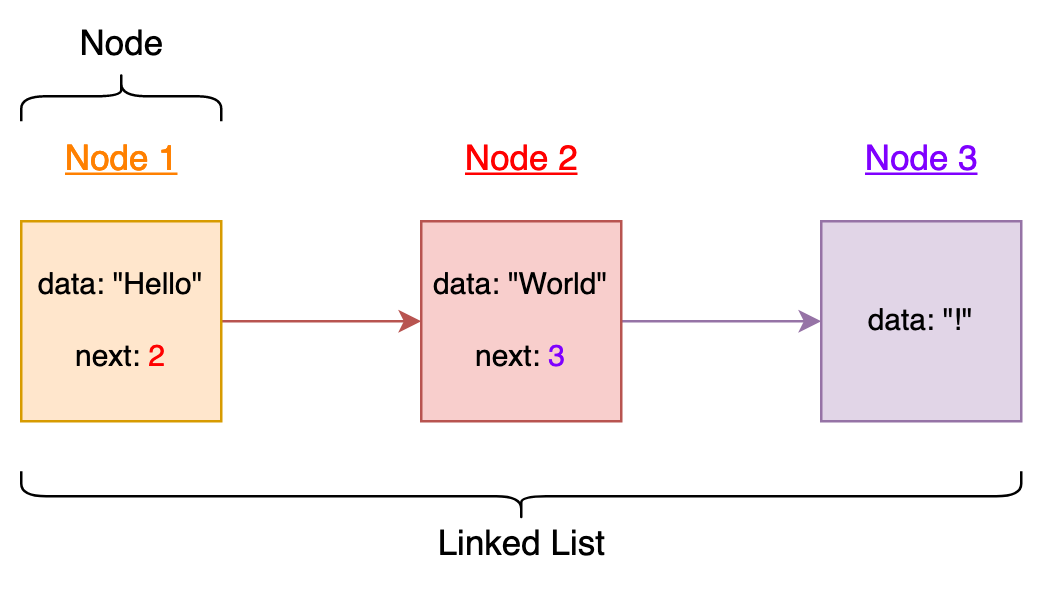
Building a Linked List in Ruby
An introduction to a common data structure
Hello there! Welcome to building a Linked List in Ruby. Linked Lists are one of the most common data structures in programming, and if you are preparing for Software Engineering interviews, you will likely come across them frequently. Linked Lists are essentially a list of items where each item points to the next one, forming a chain. Each item contains some information, and a pointer to the next item. From now on, we will call these items Nodes. A visualization of a linked list can be seen below:

Linked Lists have benefits that cause them to be preferable over arrays in come cases, but also some drawbacks. It is faster to add and remove items from a linked list than an array, but is is slower to look up items.
Alright, lets dive right on in!
Table of Contents
Part 1: The Node
A linked list is typically implemented with two classes: a Node and a LinkedList. Lets start off by building our Node class, which we will use for each individual item within the list.
class Node
attr_accessor :data, :next_node
def initialize(data, next_node)
@data = data
@next = next_node
end
end
Each new Node will be initialized with data and a next_node. We want to be sure to give the class an attribute accessor for both values, so we can both read and write them. Note that when we create a new Node, next will be automatically initialized as nill if we don’t pass a value.
Part 2: The Linked List
class LinkedList
def initialize(data)
@head = Node.new(data, nil)
end
def first
@head
end
def last
current = @head
while current.next_node != nil
current = current.next_node
end
current
end
def add(data)
current = @head
while current.next_node != nil
current = current.next_node
end
current.next_node = Node.new(data, nil)
end
def remove
return if @head == nil
if @head.next_node == nil
@head = nil
end
previous = @head
current = @head.next_node
while current.next_node != nil
previous = current
current = current.next_node
end
previous.next_node = null
end
def add_first(data)
@head = Node.new(data, @head)
end
def remove_first
return if @head == nil
@head = @head.next_node
end
def length
counter = 0
current = @head
while current != nil
counter += 1
current = current.next_node
end
counter
end
def clear
@head = nil
end
def print
current = @head
while current != nil
puts current.data
current = current.next_node
end
end
end
Here I have included a few of the standard methods you will see in linked lists. Lets walk through them one by one!
first
This one just returns the head of the list!
last
This one is a bit more complex, but it will lay the foundation for many of the methods to come. In order to reach the last node, we need to loop through the list. To do that, we set a variable current to the head of the list. Then, as long as current has a next node, we set the value of current to that next node. Once we reach a node that doesn’t have a next_node, we must have reached the end of our list! Then we can simply return the value of current, which is our last node.
add
add will accept an argument of data and add a new node with that data the to the end of the list. To do this, we need to loop through the list in the same way we did in out last method, but instead of returning the last node, we set its next_node value to a new Node, passing in data.
remove
remove will remove the last node from the list. In this method we will use some guard clauses to avoid running the entire method if we don’t need to. If the list has no head, then there is nothing to remove, and we should return out of the function. If the head had no next value, then we will remove the head. Besides those two cases this method also works similarly to the last method. However, this time, we want to set current to @head.next_node and previous to the head. This is because in order to remove the last node, we need to set the second_to_last node’s next_node value to nil. SO then we can loop through out list again, and once we have reached the end, set the value of previous.next_node to nil.
add_first
For this method, we want to add a ned head to our list, and set its next_node value to the original head.
remove_first
Here we are using another guard clause to return out of our method early if there is no head, just like in remove. Otherwise, we can set the value of head to the current head’s next node.
length
We want this method to return the number of nodes in our list. Once again, we are going to loop through our list, but we will also increment a counter with each loop. Once we have reached the end of the list, we return that counter, giving us the total length.
clear
This one is nice and short. We can just set the value of the head to nil. With no head, there is no list!
This method will print out the data of each node in our list. One more time, we will loop through the list. In each loop, before setting the value of current to the next node, we want to puts the data of current.
Congrats!
You have now implemented a linked list in Ruby! Thank you so much for reading, and good luck with your job search if thats what brought you here!